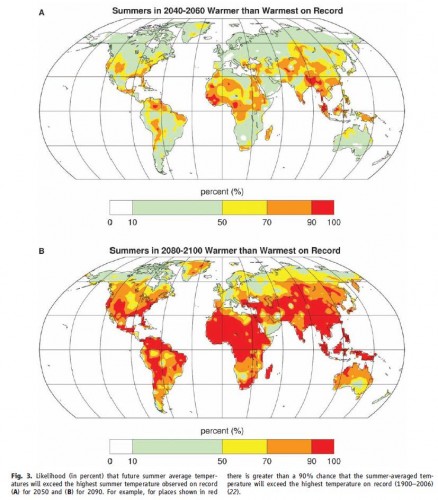What do you get when you have a shift in climate that leads to higher food prices, which destabilizes already unstable political regimes, leading to higher oil prices, which in turn lead to higher food prices? You get a big problem. Most people think of rising oceans when they think of global warming, but I have long suspected that the rising oceans will be the last thing we have to worry about. Human nature is a much more immediate and dangerous consequence of global warming.
As the world’s food prices hit a record high in January, driven by the price increases in wheat, corn, sugar and oil; Egypt’s protesters demanded and succeeded in the resignation of Hosni Mubarak’s 30-year rule.
The food inflation that exceeded the price spike of 2008, pushed millions further into poverty as Egyptians have historically spent over 40% of their income just on food. According to the UN, grain in particular, is more expensive than ever, with corn prices up 53% in 2010, wheat up 47% and rice now at its highest level in more than 2 years.
Various factors are being blamed and economists are citing a combination of influences. Unusual weather events are stated as a key contributor, namely the sweltering heat wave that struck Russia in 2010, the world’s largest wheat supplier, causing the Russian government to halt grain exports for the year, shooting up the price of bread in Tunisia and Egypt.
One thing is certain, as political unrest spreads to North Africa, protesters showed the debilitating effect of high food prices on a society. The struggle for basic food however, reaches far beyond Egyptian borders, nearly 1 billion people world-wide suffer from hunger. Untamed weather in other parts of the world contributed to global food shortages, heavy rains in Australia damaged wheat crops, flooding in Pakistan damaged grain crops and drought is currently threatening wheat crop in parts of China. According to NOAA (National Oceanic and Atmospheric Administration), 2010 tied 2005 with the hottest year on record and 2010 was also the wettest year on record, undeniably contributing to world-wide food shortages.
Population growth has also contributed to the growing demand for food. According to the World of Food Science, since 2000 the population growth has grown by more than 800 million and continues to grow by more than 80 million annually.
According to USAID, “Several factors contributed to the rapid spike in global food prices, including increased consumer demand for food, oil and energy supplies among emerging markets such as China and India, leading to rising energy costs, lower crop yields resulting from adverse weather conditions, and higher corn prices stemming from increased biofuel production.”
And don’t think that we can just switch to bio-fuel to solve out oil problems. The global diversion of cropland to produce biofuels rather than food has been severely criticized and listed as a major factor in the price spikes. Lester Brown, President of the Earth Policy Institute recently reported, “The production of Ethanol uses 4.9 billion bushels of corn in the U.S., that’s enough grain to feed 350 million people.”
The only way to solve this spiral into chaos is to address the root of the problem. Global warming. The good thing is that the solution is a positive upward spiral out of trouble. Renewable energy sources of energy free up oil supplies for places that have not switched over yet, lowering oil prices, while at the same time dealing with the problems that are causing the shift in climate, while at the same time developing jobs, which creates a strong middle class which stabilizes politically vulnerable areas.
More here (pdf)

